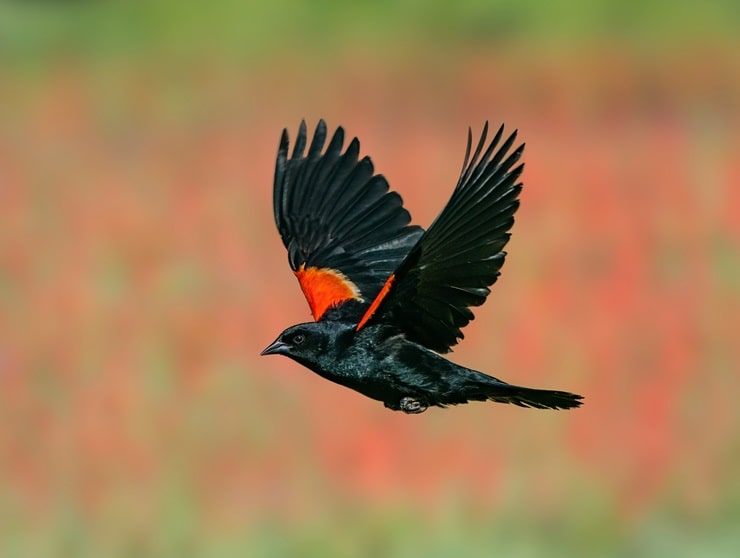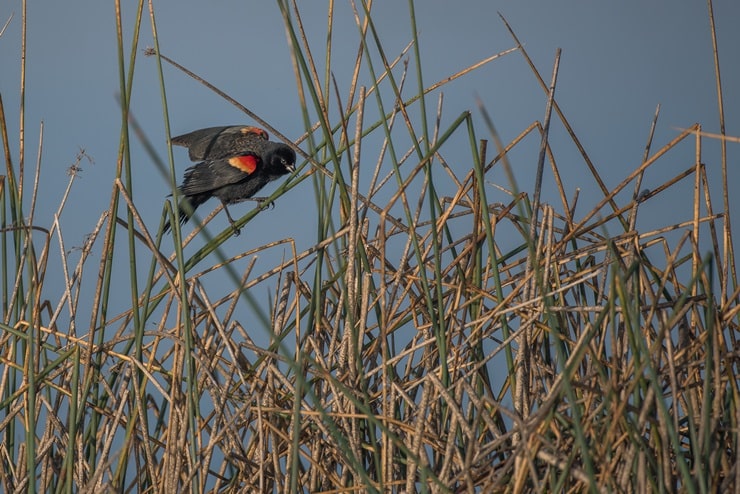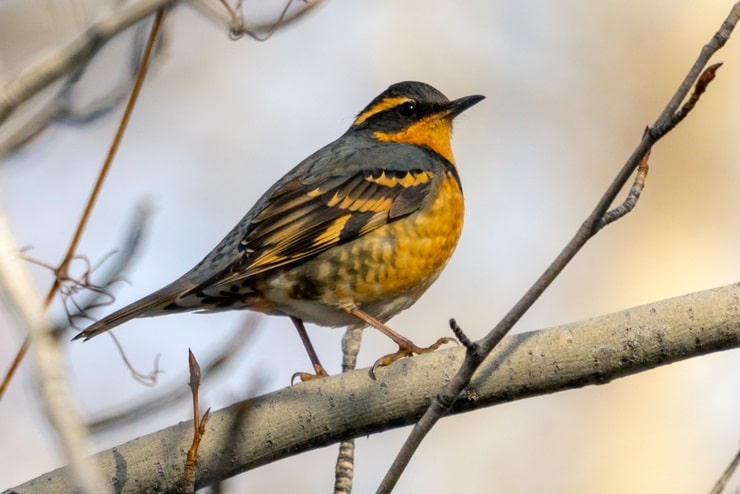Birds have always fascinated people and, in recent years, they have garnered the attention of millions. If you go out into nature to experience them in their natural habitats, you may notice several of them look alike but are vastly different.
Here’s a list of black bird species with orange wings:
Table of Contents
5 Black Birds with Orange Wings
1. Red-Winged Blackbird
- Scientific name: Agelaius Phoeniceus
- Family: Icteridae
- Size: 17 to 23 centimeters
- Weight: 32 to 77 grams
- Wingspan: 31 to 40 centimeters

- Male red-winged blackbirds are commonly stocky blackbirds with broad shoulders, orange patches that are bordered in yellow, and a slender, conical beak. Females have similar builds with a bit of yellow around their conical bills, but their brown streaked feathers don’t fit their name.
- Red-winged blackbirds live in all three North American countries and also can be found in most Central American countries.
- Red-winged blackbirds love both fresh and salt water, so they can be found near marshes, streams, water hazards on golf courses, and water along roads. Some do prefer drier places and can be found in fields, pastures, and feedlots, particularly in the winter.
- Red-winged blackbirds’ diet mostly consists of beetles, spiders, millipedes, caterpillars, grasshoppers, and snails.
- Those living in northern parts of North America tend to move south in the winter, but red-winged blackbirds that live in the southern and some western parts of North America never migrate.
- Loose colonies are preferred by red-winged blackbirds to breed . Females will have one to two broods per year with two to four clutches per brood.
- While the average lifespan of a red-winged blackbird is two years, the oldest wild red-winged blackbird lived for fifteen years and nine months.
2. Baltimore Oriole
- Scientific name: Icterus Galbula
- Family: Icteridae
- Size: 17 to 19 centimeters
- Weight: 30 to 40 grams
- Wingspan: 23 to 30 centimeters

- Males of these medium-sized birds have black heads and backs with orange rumps and outer tail feathers, sturdy bodies, thick necks, long legs, and pointed bills. Females appear with similar statures but have plumage that varies from brown to yellowish on their heads and backs with yellow tails and under coverts.
- Baltimore orioles are found in eastern parts of North America with the highest concentration in the Northeastern or Midwest regions of the United States.
- Though Baltimore orioles do not favor deep forest settings, they can be found in high, leafy deciduous located in open woodlands, forest edges, orchards, or trees planted near rivers, parks, or backyards.
- Baltimore orioles consume bugs, including beetles, hairy caterpillars, spiders, wasps, grasshoppers, and snails along with berries, nectar, and some cultivated fruits.
- Baltimore orioles seek warmer climates in the winter and have medium- to long-migration patterns that span from Florida to northern South America.
- Nesting together in colonies, female Baltimore orioles have the task of weaving the nests together while males will bring them materials. Females typically have one brood per year that is made up of three to seven clutches.
- The Baltimore oriole is the state bird of Maryland but is a popular bird of Missouri.
3. Tricolored Blackbird
- Scientific name: Agelaius Tricolor
- Family: Icteridae
- Size: 18 to 24 centimeters
- Weight: 40 to 75 grams
- Wingspan: 26 to 33 centimeters

- Male tricolored blackbirds are broad-shouldered with red patches bordered in white, a hunchback, and a conical beak. Females tend to be slender and thick-bodied with a gray-brown color, streaked bellies and backs, and distinctive yellow eyebrows.
- Tricolored blackbirds live in the Pacific region of the United States (mostly in central California) but have been found in Baja California, Mexico.
- Though tricolored blackbirds were almost exclusively found in wetlands, many have dried up, so they have been forced to make their homes in farmland.
- They consume beetles and weevils (Coleoptera), grasshoppers, moth and butterfly larvae, and caddis fly larvae (Trichoptera).
- They are non-migratory birds but will fly up to three miles to find food.
- Tricolored blackbirds breed in dense colonies, preferring to nest near water sources. Females usually have two or more broods with three or more clutches per brood.
- In the 1930s, one colony of around 300,000 tricolored blackbirds (today’s population) took up 59 acres of land.
4. Varied Thrush
- Scientific name: Ixoreus Naevius
- Family: Turdidae
- Size: 19 to 26 centimeters
- Weight: 65 to 100 grams
- Wingspan: 34 to 38 centimeters

- Male varied thrushes are stocky, round-headed, and straight-billed with blue-gray backs, black breastbands, and orange bellies and over the eyes. Females and immature males appear very similar but are brown instead of black.
- Varied thrushes live in western North America and are found as far north as Alaska and as far south as Baja California, Mexico.
- Loving the damp underbrush of evergreen trees, varied thrushes make nests deep in forests.
- Varied thrushes consume beetles, ants, caterpillars, and crickets as well as some fruit.
- Varied thrushes seek warmer southern climates in the winter and may even move to the Midwest or Northeastern parts of the United States.
- Female varied thrushes make mossy, open-cup nests by themselves near water sources in low branches or bushes. They have two broods per year and one to six clutches per brood.
- Male varied thrushes are very protective of small food sources and have been seen attacking other varied thrushes and bird species at backyard feeders.
5. Allen’s Hummingbird
- Scientific name: Selasphorus Sasin
- Family: Trochilidae
- Size: 7.6 to 9 centimeters
- Weight: 2 to 4 grams
- Wingspan: 11 centimeters

- Male Allen’s hummingbirds are compact and stocky with reddish-orange throats, orange underbellies, and narrow, needle-like bills. Females and immature males have dull green backs and pale coppery flanks.
- Allen’s hummingbirds live in coastal California and Oregon.
- These coastal birds like forests, scrub, and chaparral near the coasts in California and Oregon.
- Allen’s hummingbirds consume nectar from flowers and tiny insects.
- In winter, Allen’s hummingbirds migrate to southwest North America, from southern California to southwest Mexico.
- After breeding, females hed into forests or thickets to make nests. She will have one to three broods per year made of one or two clutches.
- To impress females, male Allen’s hummingbirds will dive 30 meters in the air at speeds up to 60 miles per hour.
